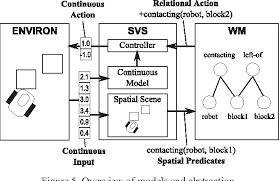
There are several ways to study cognitive robots. The classic symbolic approach emphasizes symbolic representations and reasoning. While biologically inspired approaches draw upon animal behaviour and neuroscience, the biologically inspired approach is more holistic. Cognitive robotics uses a mixture of both. The aim is to create robots that can mimic human behavior. While a variety of methods are being developed, it is still relatively challenging to create a system that can do the same things as human beings.
Human empathy
Empathy is one the most fundamental elements of interpersonal relationships. Empathy is an essential component of maintaining relationships with other people. Robotic agents may also be able to benefit from this ability. This article describes a few ways that robots and humans can improve their ability to empathize with each other. This article also explains how artificial agents can mimic empathy. This topic is crucial for robotics research. To learn more, read Rosenthal-von-der-Putten's article.
While researchers are busy developing social robots for their purposes, there is still much confusion over what empathy really is. This is particularly important considering the rise of social robots and growing interest in socializing them. Philosophers and psychologists might not agree on the nature and importance of empathy, but it is possible that the delay in drawing conclusion could have social or moral consequences. Robotics has made great progress in the interim.

Computational intelligence
Researchers believe LIDA can also be applied to cognitive robots in order for them to learn and act from the environment. Franklin envisions an auto-towing system that can transport a container from the sorting area to a plane, or ship overnight. While overnight shippers rely on tugs to move their containers, an automatic tug can be driven by an algorithm that learns from the computer. Robotics are used in two US Defense Advanced Research Project Agency competitions, the Grand Challenge Race Race and Urban Challenge. These competitions have a human component.
A recent article in Science has demonstrated that using the Multi-Kernel Support Vector Machine as a robotics model can make robots understand and act appropriately in complex situations. The Multi-Kernel SVM algorithm has been used to train robotic platforms to perform inspection and intervention tasks. The authors discuss cognitive supervision in robotics. They explain how the robot can construct and analyze a cognitive map quickly and reconstruct a 3D scene.
Biologically-inspired approaches
Biologically-inspired robotics is a method that seeks to replicate the behavior of animals. These animals have robust and flexible behavior, and researchers hope to mimic those characteristics in robots. There are some similarities between these systems' principles, but there are also important differences. Biologically-inspired robotics uses various aspects of animals as inspiration for robotic systems, ranging from a vague resemblance to strict emulation.
Biologically-inspired approaches to robot cognation have many advantages. First, they can be built very small and portable. They don't require a large power source or actuators. This makes them great for mobile use. A bio-inspired robot can be built using lightweight and compact components. It doesn't really matter which method is used, but it is vital that the robot's functionality does not be limited by its size or weight.

Electronic communication
The goal of robotic human interaction is to communicate robot intentions to humans. This task requires robots to use visual communication to communicate long-term or short-term goals. Short-term intentions generally indicate movements that will happen within a few seconds. Robots act on the basis of their intentions. It is important to examine how robots perceive signals, in order to better understand how they communicate. This section will explain how robots and humans communicate, as well as how signals may affect their intentions.
First, participants were required to observe a robot being moved around a given room. Once they were instructed, they were asked for their opinions on a questionnaire. There were two parts to the questionnaire. The first asked for participants' opinions on the robot's movement and the second asked them to rate their confidence. Each question was related to a specific stage of the experiment. Participants were asked to guess where a robot would land when it reached the fourth phase.
FAQ
What's the status of the AI Industry?
The AI industry is growing at an unprecedented rate. There will be 50 billion internet-connected devices by 2020, it is estimated. This will enable us to all access AI technology through our smartphones, tablets and laptops.
This will also mean that businesses will need to adapt to this shift in order to stay competitive. If they don’t, they run the risk of losing customers and clients to companies who do.
You need to ask yourself, what business model would you use in order to capitalize on these opportunities? Could you set up a platform for people to upload their data, and share it with other users. Maybe you offer voice or image recognition services?
No matter what you do, think about how your position could be compared to others. While you won't always win the game, it is possible to win big if your strategy is sound and you keep innovating.
Is Alexa an Ai?
The answer is yes. But not quite yet.
Amazon created Alexa, a cloud based voice service. It allows users to communicate with their devices via voice.
The Echo smart speaker was the first to release Alexa's technology. Other companies have since created their own versions with similar technology.
These include Google Home, Apple Siri and Microsoft Cortana.
What is AI and why is it important?
In 30 years, there will be trillions of connected devices to the internet. These devices will include everything from fridges and cars. Internet of Things (IoT), which is the result of the interaction of billions of devices and internet, is what it all looks like. IoT devices will be able to communicate and share information with each other. They will also have the ability to make their own decisions. A fridge may decide to order more milk depending on past consumption patterns.
It is estimated that 50 billion IoT devices will exist by 2025. This is an enormous opportunity for businesses. But, there are many privacy and security concerns.
How will AI affect your job?
AI will replace certain jobs. This includes drivers of trucks, taxi drivers, cashiers and fast food workers.
AI will create new jobs. This includes business analysts, project managers as well product designers and marketing specialists.
AI will make existing jobs much easier. This includes positions such as accountants and lawyers.
AI will make it easier to do the same job. This includes salespeople, customer support agents, and call center agents.
How will governments regulate AI?
Governments are already regulating AI, but they need to do it better. They need to make sure that people control how their data is used. They must also ensure that AI is not used for unethical purposes by companies.
They also need ensure that we aren’t creating an unfair environment for different types and businesses. Small business owners who want to use AI for their business should be allowed to do this without restrictions from large companies.
Which industries use AI more?
Automotive is one of the first to adopt AI. BMW AG uses AI, Ford Motor Company uses AI, and General Motors employs AI to power its autonomous car fleet.
Other AI industries include insurance, banking, healthcare, retail and telecommunications.
Statistics
- While all of it is still what seems like a far way off, the future of this technology presents a Catch-22, able to solve the world's problems and likely to power all the A.I. systems on earth, but also incredibly dangerous in the wrong hands. (forbes.com)
- By using BrainBox AI, commercial buildings can reduce total energy costs by 25% and improves occupant comfort by 60%. (analyticsinsight.net)
- In 2019, AI adoption among large companies increased by 47% compared to 2018, according to the latest Artificial IntelligenceIndex report. (marsner.com)
- That's as many of us that have been in that AI space would say, it's about 70 or 80 percent of the work. (finra.org)
- In the first half of 2017, the company discovered and banned 300,000 terrorist-linked accounts, 95 percent of which were found by non-human, artificially intelligent machines. (builtin.com)
External Links
How To
How to make an AI program simple
It is necessary to learn how to code to create simple AI programs. Although there are many programming languages available, we prefer Python. There are many online resources, including YouTube videos and courses, that can be used to help you understand Python.
Here's a quick tutorial on how to set up a basic project called 'Hello World'.
You'll first need to open a brand new file. On Windows, you can press Ctrl+N and on Macs Command+N to open a new file.
Type hello world in the box. Enter to save your file.
Now, press F5 to run the program.
The program should display Hello World!
This is just the start. These tutorials will show you how to create more complex programs.